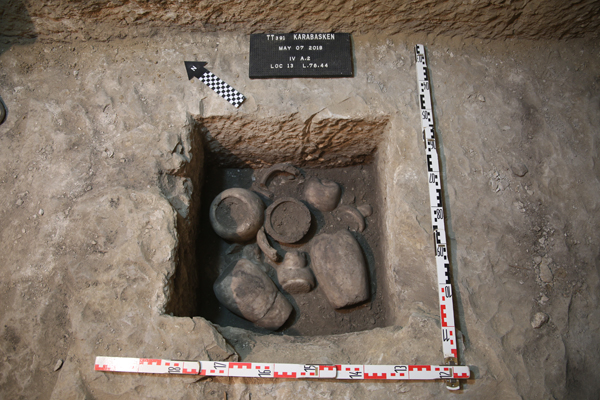Excavators at a tomb in Luxor have found four canopic jars from the 26th Dynasty, dedicated to “the lady of the house Amenirdis.”
The discovery was made by an Egyptian-American mission led by Elena Pischikova and Fathy Yassin during conservation work carried out by the South Assasif Conservation Project in the Kushite tomb of Karabasken, a priest.
The tomb is located in the south Asasif Necropolis on Luxor’s west bank.
Mostafa Waziri, the secretary-general of the Supreme Council of Antiquities, told Ahram Online that the jars were found in situ in an intrusive burial compartment cut into the south wall of the pillared hall of the tomb (TT391).
They were found in a 50cm-deep space in the floor.
“Although the jars are in situ in a very good conservation condition, they had fallen over the time under the pressure of flood water and one of them was broken into several fragments,” Waziri said, adding that emergency cleaning and consolidation were carried out by the ministry’s conservators.
Pischikova said that the jars are hollow inside and probably held viscera.
“Although the contents of the jars were damaged by floodwater they still contain a large amount of resin,” she told Ahram Online.
The sizes of the lidded jars vary from 35.5 to 39.4cm and each one bears inscriptions to “the lady of the house Amenirdis,” arranged in two vertical columns and one horizontal line.
The formula is indicative of the 26th dynasty.
The lids are in the shapes of a man, a baboon, a jackal and a falcon, and were skilfully carved by at least three different artists.
The South Asasif Conservation Project is an Egyptian-American mission working under the auspices of the Ministry of Antiquities.
The project was founded in 2006 with the aim of restoring and reconstructing the damaged and partially collapsed Late Period tombs of the South Asasif necropolis, Karabasaken (TT 391), Karakhamun (TT 223) and Irtieru (TT 390).
During its 12 years of work the project has found thousands of fragments of tomb decoration and reconstructed the Second Pillared hall and part of the First Pillared hall in the tomb of Karakhamun.
"The restored tombs will feature sophisticated relief carving and painting of the 25th and 26th dynasties," Pischikova said.

canopic jars as found
Short link: